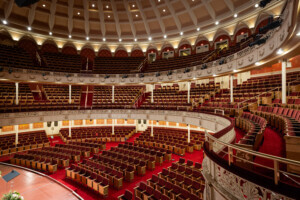Today marks the one-year anniversary of the inferno-seen-around-the-globe that ravaged Cathédrale Notre-Dame de Paris.
All things considered, Parisian officials will not hold a formal organized event or encourage any mass gatherings to mark one of the most dispiriting structural fires in recent memory. However, the medieval cathedral’s 13-ton bourdon bell, Emmanuel, tolled this evening for only the second time since the blaze on April 15, 2019, gutted the 850-year-old Gothic edifice regarded as the “Soul of France.”
At 8:00 p.m. GMT, Emmanuel rang from the cathedral’s south tower in a bit of timing that coincides not only with the time that the cathedrals’ iconic spire toppled but also with the chorus of raucous cheers and applause that fill the streets of Paris nightly in recognition of the front line responders battling the coronavirus. As noted by Reuters, the tolling is in tribute to both Notre Dame’s remarkable resilience and the medical professionals risking their lives on a daily basis during the pandemic. (As of this writing, 15,729 people have succumbed to the virus across France.)
Hear the bells of Notre Dame, ringing today for healthcare personnel in France. https://t.co/8TF6ks8mEq
— Peter Sokolowski (@PeterSokolowski) April 15, 2020
As for the cathedral’s aforementioned resilience, it is indeed still standing tall over Ile de la Cité, although hidden beneath fire-damaged scaffolding and in an increasingly fragile and vulnerable state.
As the Associated Press wrote of Notre Dame’s present state in somewhat purple terms: “Notre Dame Cathedral stands crippled and alone, locked in a dangerous web of warped scaffolding one year after a cataclysmic fire gutted its interior, toppled its famous spire, and horrified the world.”
Despite a delay in restoration work of unforeseen length due to the coronavirus, officials are confident that Notre Dame will open its doors and more closely resemble its former self by 2024, a just-ahead-of-the-Summer-Olympics completion date promised by French President Emmanuel Macron. Undeterred by pauses, pandemic-related or otherwise, Jean-Louis Georgelin, the retired army general charged with overseeing the cathedral’s restoration, is optimistic that the five-year restoration plan will not drag out any further.
“If everyone rolls up their sleeves and the work is well planned, it is conceivable that returning the cathedral to a place of worship within five years will not be an impossible feat,” the Guardian reported Georgelin as saying. “Obviously, the area around the cathedral will be far from finished, and perhaps the spire will not be completed, but the cathedral will once again be a place of worship and this is our aim.”
All work on Notre Dame was halted on March 17 when France entered nationwide lock-down mode and the restoration project’s small army of specialized craftsmen, known as compagnons, were dismissed.
While the unknown duration of the coronavirus shutdown presents a unique challenge to the all-hands-on-deck restoration efforts, work has stopped a small handful times over the past year, including during a high wind event and for a more lengthy and necessary pause to mitigate substantial lead contamination.
There’s also the issue of the spire, which has become something of a point of contention over the past year as different factions have argued whether to faithfully restore Eugene-Emmanuel Viollet-le-Duc’s 19th-century design or to create a new, contemporary spire.
Like with the restoration process in general, Georgelin is determined not to let any spire-squabbling slow things down. “We have to be left to get on with the work and not caught up in the controversies,” the Guardian noted him as relaying to L’Express magazine. “The quicker the decision is made about the spire, the quicker we will be able to really concentrate on the real reconstruction. It’s important that the objectives are set.”
The tangle of scaffolding enveloping the cathedral, which went up just prior to the near-catastrophic blaze as part of a $6.8 million dollar restoration effort, is of particular concern, especially now that the site has largely been vacated. The scaffolding, referred to by the New York Times in 2019 as a “mass of twisted metal roughly 250 tons that is weighing down the structure,” is at high risk of collapsing—a roughly 50 percent according to experts—and meticulously removing it is a key element of assessing existing damage and then swiftly repairing it.
If any single element of the repair and restoration process presents a race-against-the-clock sense of urgency, the removal of the scaffolding, which was slated to commence in March, is it. But the clock has now stopped.











